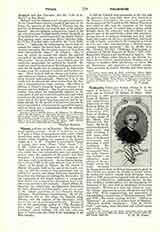

Tipasa, a titular see of Numidia. The Phoenician word signifies passage. Early in its history we find in Tipasa a Punic counting-house with a port; which passed later under the dominion of the kings of Mauretania, whose kingdom was annexed to the Roman empire in A.D. 39. Claudius I constituted Tipasa a Colonia juris latini (Pliny, “Hist. Natur.”, V, ii, 20). Later on it became a civitas and in the third century an inscription styles it colonia. The city, which was very commercial, grew and prospered greatly under the emperors of the second and third centuries. A Jewish colony with its synagogue settled there, early in its history. An inscription belonging to the year 238 is the most ancient trace of Christianity to be found in Tipasa. In the church of Bishop Alexander, built at the end of the fourth century, we find the tombs of nine personages who are called justi priores and whom Duchesne considers to have been nine bishops antedating this Alexander. In the beginning of the fourth century, a young girl, Saint Salsa, was martyred by the pagans; later a basilica was erected to her memory. Under Julian the Apostate the inhabitants distinguished themselves by their adherence to Christianity, and this in spite of the violent opposition of two Donatist bishops (Optatus, “De Schismate Donatistarum”, II, 18-19).
Likewise in 371 or 372, when the Moorish king, Firmus, with the support of the Donatists, tried, but in vain, to take possession of the city. Mention is due to the anonymous author of “The Passion of Saint Salsa” and “The Passion of Saint Fabius of Cartenna” (Anal. bolland., IX, 123-134), who was born at Tipasa and who lived in the beginning of the fifth century.
In 429 the Vandals took possession of the city and the province; ten years later these were restored to the Emperor Valentinian, but came back again into the possession of the Vandals in 455. Bishop Reparatus was exiled in 484, and the secretary of the Arian patriarch was chosen to replace him, a choice which brought about the voluntary exile into Spain of the greater part of the inhabitants; those who remained, having refused to embrace Arianism, had their right hand and tongue cut off, but, nevertheless, continued to talk as before, according to the testimony of Victor de Vita and other contemporaries (“Historia persecutionis Africanae provinciae”, III, vi, 29-30; Acta SS., October, XI, 847; “Mélanges d’archéologie et d’histoire de l’Ecole française de Rome“, XIV, 319). Henceforth Tipasa is not mentioned in history. Today it is a village, called Tipaza by the French, Tefassed by the natives, situated about 44 miles east of Algiers; it numbers 2400 inhabitants, of whom 600 are Europeans, and possesses a Catholic parish. There are ruins of several churches and other monuments.
S. VAILHÉ.

